Growing Your Own Food: As talks of food shortages keep popping up around the world, there is no better time than now to start becoming food sovereign. The thought can be daunting to most, but the reality is that no matter how much space you have, there is always a possibility to start growing some food at home. This article explores some simple ways to start growing food at home and some of how it can benefit your whole family.
The Benefits of Growing Your Own Food
1. Mental Health

Caring for anything provides great mental health benefits, including improved mood, increased self-esteem, and increased attention span 1, 2. It is incredibly rewarding to cultivate something from nothing, and even more so when the result goes to nourishing you or your family. The mental health benefits can go even further if you garden in a community garden, allowing for human connection and community bonding!
A form of bacteria known as Mycobacterium vaccae found in dirt has been shown to act like a natural anti-depressant that mirrors the effect on neurons of Prozac 3.But, of course, this comes with all the other benefits that gardening offers, without any pharmaceutical side effects!
2. Physical Health

Gardening supports physical health, including getting in different movements and boosting your microbiome. You need to mix up your physical activities, just like you need different nutrients. Variety is key, and we need to include big and small movements, both of which you benefit from while gardening. From squatting and digging to pruning, picking, and washing: growing your food encourages you to move in ways many of us no longer do.
Exposure to dirt, especially outside, will support a healthy microbiome by exposing you to good bacteria. Yes, you can breathe beneficial bacteria into your microbiome just by spending time outdoors in nature 4. You’ll especially benefit during times of harvest when pulling things out of the ground releases an abundance of good bacteria into the air!
3. Paradigm Shifting
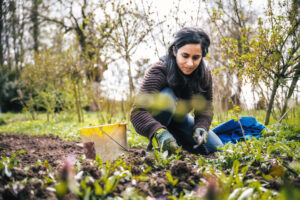
Growing your food is stepping out of the paradigm of reliance on the food system that most of us grow up with. In a world of processed foods, growing your own food reclaims a kind of power that enables you to be more self-reliant and liberated.
It does not have to be a quantum leap all at once from relying on the system to being completely self-sufficient– but start somewhere. Every part of your diet that you begin to grow at come is a step into greater and greater food sovereignty!
4. Growing Your Own Food: Great to Teach Kids

Growing your own food encompasses many life lessons in a fun and interactive way for children. Some key teachings about growing even the smallest plants (like herbs on your countertop) include responsibility, patience, and nurturing.
You may not have the time or space for a pet, but kids can get many of the same benefits by taking care of living plants and cultivating great pride and self-esteem by contributing to the family meals with plants they have grown themselves.
How to Start Growing Your Own Food in Small Spaces
1. Get a Window Box
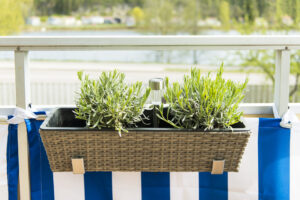
Whether you live in a bigger house with a yard or a smaller apartment with none, most people can open a window and install a planter box on the window sill. Window boxes make great planters for salad, herbs, and even strawberries. If you have a window in your kitchen, you will have easy access to fresh homegrown food from the window straight into the kitchen!
2. Mobile Planters
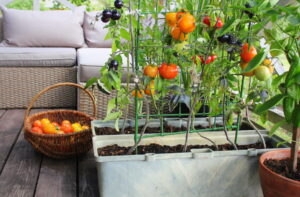
Using mobile planters is a great way to grow food flexibly if you live in a smaller place. If you have a small backyard that doesn’t get full sun, you can easily move planters around with the sun, into the shade, or indoors, depending on what you’re growing. If you have friends or family over, you can easily move the planters out of the way to make more space.
Five-gallon buckets make great planters for carrots, potatoes, and beets; just make sure you put drain holes in the bottom! Keep the handles on or add wheels to the buckets for easier mobility.
3. Go Vertical

If you’re short on space, consider growing upwards. Many plants, including tomatoes, sugar snap peas, green beans, and cucumbers, grow vertically very well. Growing on a trellis or simple poles can help support your food as it grows. If you’re short on space, consider growing upwards.
4. Start Simple
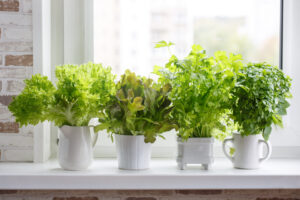
Herbs and tomatoes are some of the simplest things to grow. A few minutes on Google, and you will have everything you need to know to get something growing. If you have a balcony, tomatoes will do great, and if you have no access to outdoor space, you can always grow herbs on the kitchen countertop!
5. Community Gardens
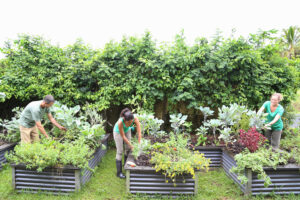
If the thought of any DIY growing is too daunting, or you just don’t have the space but would like to start growing a decent amount of food: community gardens are where it’s at. The community garden is not only a fantastic place to learn what is suitable to grow in your climate, but people are typically super kind and helpful.
Getting a small plot in your community garden also benefits your human connection and movement needs (even better if you can walk or bicycle there). It’s also great to boost your microbiome with various plants growing everywhere.
Summary
Growing your own food is an act of sovereignty and liberation, with many incredible benefits. Support your mental and physical health, and teach kids in a fun and interactive way. No matter how much space you have, you can start to grow food at home by getting creative. Consider using a window box, using mobile planets, or going vertical. Start simple, and consider working alongside locals at your neighborhood community garden.
Medical Disclaimer: information on this website is not intended to replace a one-on-one relationship with a qualified health care professional and is not intended as medical advice. It is intended to share knowledge and information. We encourage you to make your own healthcare decisions based on your research and in partnership with a qualified healthcare professional.
References
- Kuo, Frances E, and Andrea Faber Taylor. “A potential natural treatment for attention-deficit/hyperactivity disorder: evidence from a national study.” American journal of public healthvol. 94,9 (2004): 1580-6. doi:10.2105/ajph.94.9.1580
- Thompson, Richard. “Gardening for health: a regular dose of gardening.” Clinical medicine (London, England) vol. 18,3 (2018): 201-205. doi:10.7861/clinmedicine.18-3-201
- 3Lowry, C.A., et al. “Identification of an Immune-Responsive Mesolimbocortical Serotonergic System: Potential Role in Regulation of Emotional Behavior.” Neuroscience, vol. 146, no. 2, 2007, pp. 756–772., https://doi.org/10.1016/j.neuroscience.2007.01.067.
- Brown, M.D., Shinn, L.M., Reeser, G. et al. Fecal and soil microbiota composition of gardening and non-gardening families. Sci Rep12, 1595 (2022). https://doi.org/10.1038/s41598-022-05387-5


